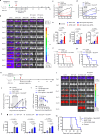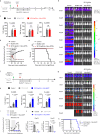Split-design approach enhances the therapeutic efficacy of ligand-based CAR-T cells against multiple B-cell malignancies
- PMID: 39528513
- PMCID: PMC11555413
- DOI: 10.1038/s41467-024-54150-z
Split-design approach enhances the therapeutic efficacy of ligand-based CAR-T cells against multiple B-cell malignancies
Abstract
To address immune escape, multi-specific CAR-T-cell strategies use natural ligands that specifically bind multiple receptors on malignant cells. In this context, we propose a split CAR design comprising a universal receptor expressed on T cells and ligand-based switch molecules, which preserves the natural trimeric structure of ligands like APRIL and BAFF. Following optimization of the hinges and switch labeling sites, the split-design CAR-T cells ensure the native conformation of ligands, facilitating the optimal formation of immune synapses between target cancer cells and CAR-T cells. Our CAR-T-cell strategy demonstrates antitumor activities against various B-cell malignancy models in female mice, potentially preventing immune escape following conventional CAR-T-cell therapies in the case of antigen loss or switching. This ligand-based split CAR design introduces an idea for optimizing CAR recognition, enhancing efficacy and potentially improving safety in clinical translation, and may be broadly applicable to cellular therapies based on natural receptors or ligands.
© 2024. The Author(s).
Conflict of interest statement
Figures






Similar articles
-
Rational design of a trimeric APRIL-based CAR-binding domain enables efficient targeting of multiple myeloma.Blood Adv. 2019 Nov 12;3(21):3248-3260. doi: 10.1182/bloodadvances.2019000703. Blood Adv. 2019. PMID: 31698455 Free PMC article.
-
Antigen-independent activation enhances the efficacy of 4-1BB-costimulated CD22 CAR T cells.Nat Med. 2021 May;27(5):842-850. doi: 10.1038/s41591-021-01326-5. Epub 2021 Apr 22. Nat Med. 2021. PMID: 33888899 Free PMC article. Clinical Trial.
-
CAR-T cell targeting three receptors on autoreactive B cells for systemic lupus erythematosus therapy.J Autoimmun. 2025 Feb;151:103369. doi: 10.1016/j.jaut.2025.103369. Epub 2025 Jan 19. J Autoimmun. 2025. PMID: 39832454
-
Conjugated CAR T cell one step beyond conventional CAR T cell for a promising cancer immunotherapy.Cell Immunol. 2019 Nov;345:103963. doi: 10.1016/j.cellimm.2019.103963. Epub 2019 Aug 10. Cell Immunol. 2019. PMID: 31445668 Review.
-
Gene modification strategies for next-generation CAR T cells against solid cancers.J Hematol Oncol. 2020 May 18;13(1):54. doi: 10.1186/s13045-020-00890-6. J Hematol Oncol. 2020. PMID: 32423475 Free PMC article. Review.
Cited by
-
CAR-T cell therapy in brain malignancies: obstacles in the face of cellular trafficking and persistence.Front Immunol. 2025 Jun 19;16:1596499. doi: 10.3389/fimmu.2025.1596499. eCollection 2025. Front Immunol. 2025. PMID: 40612954 Free PMC article. Review.
-
The Struggle Between Chimeric Antigen Receptor T-Cell Therapy and Neurological Complications in Acute Lymphoblastic Leukemia Treatment.Curr Issues Mol Biol. 2025 May 21;47(5):381. doi: 10.3390/cimb47050381. Curr Issues Mol Biol. 2025. PMID: 40699780 Free PMC article. Review.
-
SynNotch CAR-T cell, when synthetic biology and immunology meet again.Front Immunol. 2025 Apr 16;16:1545270. doi: 10.3389/fimmu.2025.1545270. eCollection 2025. Front Immunol. 2025. PMID: 40308611 Free PMC article. Review.
References
-
- Majzner, R. G. & Mackall, C. L. Tumor antigen escape from CAR T-cell Therapy. Cancer Discov.8, 1219–1226 (2018). - PubMed
-
- Shah, N. N. et al. Bispecific anti-CD20, anti-CD19 CAR T cells for relapsed B cell malignancies: a phase 1 dose escalation and expansion trial. Nat. Med. 26, 1569–1575 (2020). - PubMed
Publication types
MeSH terms
Substances
Grants and funding
LinkOut - more resources
Full Text Sources
Miscellaneous

